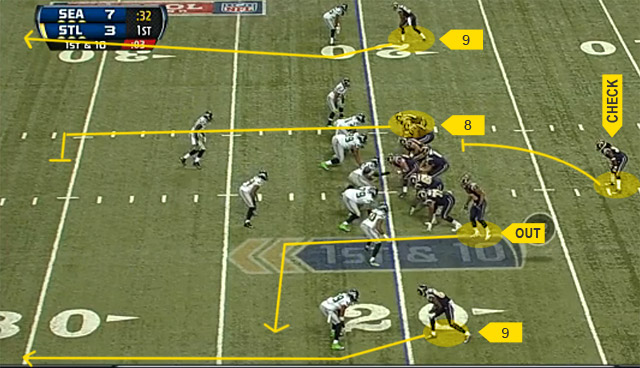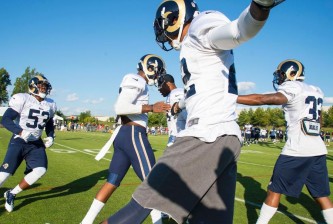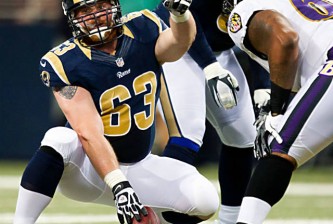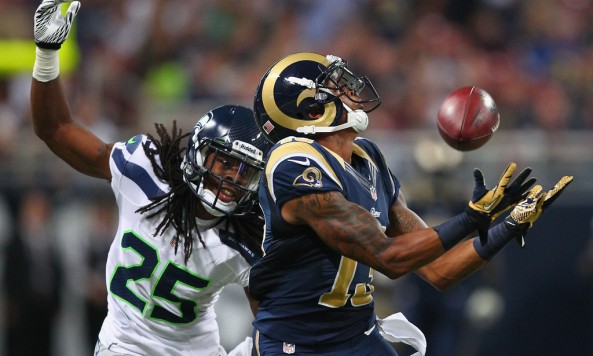| Situation: | 1st and 10 from the St. Louis 20 yard line, with 0:40 left in the first quarter, trailing by 4 |
| Personnel: | 12 |
| Play: | Deuce Right Jam 989 Out, Givens on a 9 route |
| Defense: | Cover 1 |
Pre-Snap
The Rams come out in 12 personnel (1 back, 2 tight ends) in a Trips right formation. Chris Givens (13) split out wide to the right and Brian Quick (83) to the left. Tight end Mike Mulligan (82) is on the line to the right of the formation and Lance Kendricks is (88) lined up 1 by 1 off the line just to the right of Mulligan. Bradford is under center with Steven Jackson 7 yards behind him.
Prior to the snap, Lance Kendricks does a Jam motion across the formation. Jam motion tells us that Kendricks is moving away from the Y receiver (here Mike Mulligan). When the tight end is aligned on the edge as Kendrick is here on the right, he initiates and ends his movement on the edge on the opposite side. The motion puts the Rams in what is known as a Deuce formation.
Offensive Playcall
The Rams are running “989 Out”. The three digit numbering system is used to call pass plays. Each number designates a receiver’s route. Typically, the numbers start with the single-receiver side and go to the two receiver side.

In this case, Brian Quick is the Rams X receiver on the single-receiver side, because the tight end is on the other side of the formation. Quick is thus running a 9 route ( 989 part of the call). 9 routes have a couple different names (e.g. Go, Fly, Streak, Fade). Mike Mulligan the Y receiver in this formation is running an 8 route (989 part of the call). An 8 route is essentially a deep in route at about 12 yards. If the middle of the field was open, Mulligan would convert his 8 route to a 4 route and keep running down the middle of the field.
Chris Givens is the Z receiver in this formation. Givens, like Quick, is running a 9 route (989 part of the call), but on the opposite side of the field.
The tag word in the play call, in this case “OUT” is for the fullback or in this formation the second tight end (here Lance Kendricks). After his jam motion takes him to the left of the formation, Kendricks will run his out at about 6 yards. Steven Jackson will do what is sometimes referred to as a hotel check, checking for inside threats first, and then outside threats before releasing on a check down route.
Defensive Alignment
On this play, the Seahawks have stacked the box with 8 defenders. On the outside, the corners play tight to the line of scrimmage with safety Earl Thomas (29) in a single-high safety look. The Seahawks are running cover 1 on the outside and with 4 zone defenders underneath.
This defense is designed to the stop the run. I’m not sure how often the Seahawks are in a two-high look, but I can tell you that on this play and on the 5 previous times the Rams came out on 1st and 10, the Seahawks came out in single-high safety look with 8 (and sometimes 9) defenders in the box. 2nd year corner Richard Sherman (25) is 1-on-1 with Chris Givens. Sherman led all rookies in interceptions last season.
Let us note that this is a great play call by Brian Schottenheimer and great execution by the Rams offense. Coming out in this defense every 1st and 10 is a statement by the Seahawks. It says that they believe they are good enough in their secondary to run with the Rams receivers. And why wouldn’t they think that? Their secondary features 3 Pro Bowlers. Despite this, the Rams attacked the Seahawks on first down throwing the football early in the game.
The fades on both sides versus this defensive look places the safety in a bind. If executed right (Quarterback's eyes, ball placement, route running) it is nearly impossible for the safety, playing in the middle of the field, to make a play on a ball outside of the numbers.
The Play
What Happens After the Snap
Chris Givens – Givens is aligned at the top of the numbers. Off the snap, Givens is going to burst out to close the cushion on the corner. In terms of inside or outside release, Givens is given the choice of the easiest release possible. The preference on this throw is to have Givens finish outside, away from the free safety. So here, Givens releases inside of Sherman. This is going to give him and Sam Bradford ample space to work back outside the numbers.
This release also eliminates the opportunity for Sherman to squeeze him to the sideline. As you may remember from the Brandon Gibson piece from week 1, the sidelines are a corner in man coverage’s best friend. It’s an extra defender working against the receiver and quarterback.
The next thing Givens has to do is win this route in about 4-5 steps. To win this route he has to burn Sherman vertically, and then stack back over the top of Sherman. This puts Sherman in a trail position, and thus, prevents him from making a play on any ball placed out in front of the receiver. As we see here, Givens and his 4.37 speed win the route and stack back over Sherman as he crosses the 35-yard line (15 yards into the route or roughly 4-5 steps after his initial release).
Notice once Givens beats Sherman he is at the bottom of the numbers, and once he begins to stack him he is at the top of the numbers. This is because, like stated above, the preference is to have this route finish outside, away from the safety playing in the middle of the field. The reasoning behind finishing outside is simple, it makes the safety’s run from the middle of the field that much longer to be able to defend on the ball. As we see, Givens eventually catches this ball about the midway point between the numbers and the sideline. It is virtually flawless execution of a 9 route.
Sam Bradford – Mike Martz called the location of this throw by Bradford “magnificent”. And really, who am I to disagree with the Mad Scientist? It really is a great display of touch by Bradford. Bradford has a 5-step drop with a hitch. 5-step with a hitch is a longer drop which allows the wide receiver to run a longer route.
The first thing Sam does is holds the free safety, Pro Bowler – Earl Thomas, to the middle of the field. He does this by staring down Thomas. As mentioned above, this is a great play call against a single-high look. The safety is in a bind. He is in the middle of the field and he has to play the entire field. A single-high safety’s only friend is his depth away from the line scrimmage. He has to essentially read the quarterback and get to the ball as fast as he can. Staring down Thomas prevents him from jumping to one side of the field or the other.
Keeping the safety in the middle of the field is only half the battle. You still need a great throw. A great throw here requires both the right trajectory and the right placement. In terms of trajectory, against a single-high safety look, the ball should have some air on it. It will allow for your receiver to run underneath of the ball and it’s possible because of the time it will take for the safety to come from the middle of the field to make a play on the ball. Next, the placement has to be out in front of the receiver, dropped over the outside shoulder (prevents Sherman from making a play on it, and outside (prevents Thomas from making a play on it.
As we see, a great throw is exactly what we get.
Result
This didn’t have quite the impact you would hope for, as Bradford was picked off two plays later. The upside, however, is that we now know we have the long-desired deep threat in Chris Givens. We also know that Bradford is capable of airing it out.























